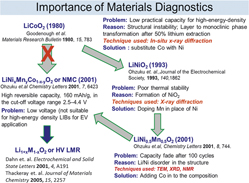Article contents
Understanding the structure and structural degradation mechanisms in high-voltage, lithium-manganese–rich lithium-ion battery cathode oxides: A review of materials diagnostics
Published online by Cambridge University Press: 21 December 2015
Abstract

Materials diagnostic techniques are the principal tools used in the development of low-cost, high-performance electrodes for next-generation lithium-based energy storage technologies. This review highlights the importance of materials diagnostic techniques in unraveling the structure and the structural degradation mechanisms in high-voltage, high-capacity oxides that have the potential to be implemented in high-energy-density lithium-ion batteries for transportation that can use renewable energy and is less-polluting than today.
The rise in CO2 concentration in the earth’s atmosphere due to the use of petroleum products in vehicles and the dramatic increase in the cost of gasoline demand the replacement of current internal combustion engines in our vehicles with environmentally friendly, carbon free systems. Therefore, vehicles powered fully/partially by electricity are being introduced into today’s transportation fleet. As power requirements in all-electric vehicles become more demanding, lithium-ion battery (LiB) technology is now the potential candidate to provide higher energy density. Discovery of layered high-voltage lithium-manganese–rich (HV-LMR) oxides has provided a new direction toward developing high-energy-density LiBs because of their ability to deliver high capacity (∼250 mA h/g) and to be operated at high operating voltage (∼4.7 V). Unfortunately, practical use of HV-LMR electrodes is not viable because of structural changes in the host oxide during operation that can lead to fundamental and practical issues. This article provides the current understanding on the structure and structural degradation pathways in HV-LMR oxides, and manifests the importance of different materials diagnostic tools to unraveling the key mechanism(s). The fundamental insights reported, might become the tools to manipulate the chemical and/or structural aspects of HV-LMR oxides for low cost, high-energy-density LiB applications.
- Type
- Review
- Information
- Copyright
- Copyright © Materials Research Society 2015
Footnotes
Notice: This manuscript has been authored by UT-Battelle, LLC under Contract No. DE-AC05-00OR22725 with the U.S. Department of Energy. The United States Government retains and the publisher, by accepting the article for publication, acknowledges that the United States Government retains a nonexclusive, paid-up, irrevocable, world-wide license to publish or reproduce the published form of this manuscript, or allow others to do so, for United States Government purposes. The Department of Energy will provide public access to these results of federally sponsored research in accordance with the DOE Public Access Plan (http://energy.gov/downloads/doe-public-access-plan).
References
REFERENCES
- 42
- Cited by




